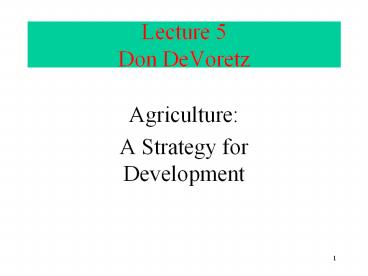Lecture%205%20Don%20DeVoretz - PowerPoint PPT Presentation
Title:
Lecture%205%20Don%20DeVoretz
Description:
Raise income per capita with productivity. Increases income equality ... Philippines, Rice IR8 and mariculture 1960s. India and Pakistan, Wheat, cotton 1970 to 1980s ... – PowerPoint PPT presentation
Number of Views:22
Avg rating:3.0/5.0
Title: Lecture%205%20Don%20DeVoretz
1
Lecture 5Don DeVoretz
- Agriculture
- A Strategy for Development
2
Roles for Ag in Development
- Raise income per capita with productivity
- Increases income equality
- Reduces rural urban migration
- Reduces population growth rate
- Reduces food imports, perhaps raises exports
3
Role of Demand
- Factors that lead to shortage
- 1. Population Growth of 2.0 per annum
- 2.Growth in income per capita of 2.5 and
- 3. Elasticity of demand for foodstuffs of unity
- Leads to annual increase in demand of 4-5 per
annum
4
Role of Supply
- 1. Tenurial arrangements
- How is productivity affected by ownership of
land? - What is APP of land, labour and capital by tenure
? - 2. Economies of Scale
- Is large more productive than smaller?
- Is there an optimal size for operation ?
- 3. Agricultural production functions
- what is role of labor, land and technology?
- 4. Technical Change
- What is labour bias in technical change ?
5
Average Productivity and Tenure
- What is optimal size ?
- Equalize MPP per unit cost
- If cost of land and capital same then X is
optimal size
APP input
APP Cap
APP Land
X
X
Hectacres
6
Scale Economies in Ag
- Start at C, small scale
- Move to B,
- Note K-Land ratio constant
- Note large increase C-B
- Move B to A
- Note K-Land ratio constant
- Note B-A less
- Conclusion, increase inputs by t does output
increase by more or less t?
Land
A
B
C
Capital
7
Green Revolution 3 Generations
- 1. First Generation Seed Revolution
- Mexico, Wheat productivity 1950s
- Philippines, Rice IR8 and mariculture 1960s
- India and Pakistan, Wheat, cotton 1970 to 1980s
- Africa, upland rice failed
- 2. Second generation
- Fertilizer pesticide
- tube well
- credit
- and marketing problem
- 3. Third generation Regional equity,
income distribution and displace worker.
8
Green Revolution 3rd Generation
- Third generation all problems
- Regional equity, north-south issue
- Productivity differences
- no land taxes in northern India
- income distribution
- Wage labour and rise in land value
- and displacement of worker to urban areas
9
Historical Growth Patterns
- Annual Change in Per Capita Food output 1950-1996
- Region LA F.E. N. E. Africa LDC
- 1948-60 .4 .8 .7 .0 .6
- 1960-70 .6 .3 .0 -.7 .1
- 1970-80 .9 .7 .7 -1.2 .5
- 1980-94 .8 1.7 1.3 .0 .9
10
What Does above tell us ?
- 1.In general, improvement for LDCs 1970-96
- 2.Large differences, Africa versus Far East
- Implications
- Poverty in rural sectors has increased in
Africa and most of Near East. - N Note 68 of African population is on land and
only produce 20 of GDP - 3. Why do these differences arise ?
- a. Population growth
- b. technological change
- c. land tenure
11
Productivity Gap
- Country Kilos grain per hec Pop
- Japan 6,119 125m
- USA 5,136 263
- Bangladesh 2,602 120
- Mexico 2,506 92m
- India 1,943 929m
- Nigeria 1,172 111m
12
What Causes Productivity Gap?Risk Aversion
- Why is technique A which is less productive than
technique B Choosen ? - Technique B Is Feed, Fertilizer Revolution
- Need Credit, irrigation and no pests
- There are no insurance schemes
- Failure is starvation
13
Risk-Productivity Trade-off
- Both Mean of 8
- Range of A
- 6 to 10
- Range of B
- 4 to 16
- Mean Variance of
- A is 8/8 1
- B is 8/10 .8
14
Tenure and Productivity
Country Mini output Mini of land Latifundio
output Latifundio of land Argentina 43.2 3.4
.8 36.9 Brazil 22,5 .5 4.7 59.5 Chile 3
6.9 .2 6.9 81.3 Peru 88.0 7.4 1.1 82.4
15
Policy Issues
- Would land redistribution
- Raise output ?
- Lower output ?
- Increase equality ?
- Lead to more democracy or violence ?
16
End of Show































